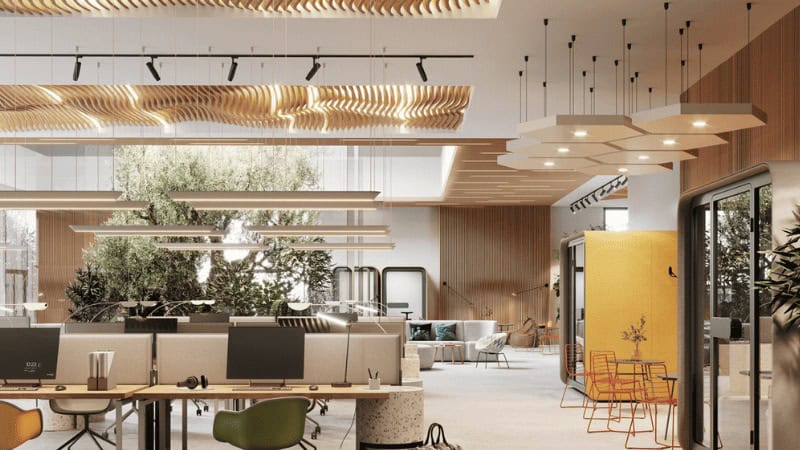Table of Contents
Office lighting has come a long way from the harsh fluorescent bulbs that once dominated workspaces. Today, lighting design plays a crucial role in shaping not just the aesthetics of offices but also employee well-being, productivity, and energy efficiency. As companies aim to create optimal environments for their teams, understanding modern trends in workplace lighting is essential.
This year, several key trends are transforming the way we think about light in the workplace. Let’s explore the top light design trends that are reshaping workspaces and how they can positively impact mood, efficiency, and energy consumption.
Office Lighting Design Trends

Emphasis on Natural Light
One of the most prominent trends in lights is the integration of natural lighting. Studies show that exposure to natural light can significantly improve mood, enhance efficiency, and help regulate the circadian rhythm, which controls the sleep-wake cycle.
Offices that prioritize large windows, skylights, and glass partitions help employees feel more connected to the outside world. It can reduce the need for artificial lighting during the day, lowering energy consumption and contributing to a more sustainable work environment.
Incorporating more windows into office designs is a powerful way to enhance an employee’s overall work experience. fosters a sense of openness, promotes better concentration, and helps regulate energy levels throughout the day.
Designers use strategies like open floor plans, glass walls, and mirrored surfaces to amplify outdoor light within the workspace. Some offices also use light shelves, reflective surfaces, or adjustable blinds to maximize the penetration of natural light without causing glare.
Human-Centric Lighting
Human-centric lighting, also known as circadian lighting, is designed to align with the body’s natural circadian rhythm. This lighting approach mimics the natural patterns of light we experience outdoors—bright and cool during the morning and early afternoon when people are typically more alert, and warmer, dimmer light in the evening for people to wind down after finishing a work day.
Research has shown that this type of lighting can improve focus on tasks, increase alertness, and even enhance sleep quality after a long day at the office.
Offices that adopt human-centric lighting systems can support employee health and wellness by helping regulate their internal clocks. This trend is particularly beneficial in environments where desk workers are often exposed to artificial lighting, such as in windowless offices or any space with inconsistent access to daylight.
Biophilic Lighting
Biophilic design is another major trend that incorporates elements of nature into the office environment to create a more soothing and productive atmosphere.
Biophilic design goes beyond just using natural light; it integrates the qualities of natural elements, such as the soft glow of sunlight filtering through trees, or fixtures designed to resemble organic shapes and colors found in nature. For example, you can incorporate a glass shade into your office design to replicate the glow of the sunlight.
Lighting design in biophilic offices often uses natural materials like wood, bamboo, and stone along with adjustable controls that mimic the changing intensities of daylight. This approach fosters a connection between employees and the natural world, promoting a space with a calming atmosphere and improving creativity. Biophilic lighting can also reduce stress and improve concentration, making it a valuable addition to any modern office.
Energy-Efficient LED Lighting
With an increasing emphasis on sustainability, LED lighting has emerged as the standard for cost-effective and environmentally friendly light sources. LED lights use significantly less energy than traditional incandescent bulbs or fluorescent bulbs, making them ideal for offices aiming to reduce their energy costs and carbon footprint in the long run.
Beyond energy savings, LEDs offer a range of benefits, including longer lifespan, better light quality, and greater control over brightness levels. LED options are now available with smart technology, allowing businesses to adjust the lights remotely, set timers, or even automate lighting based on occupancy or daylight levels.
Smart Lighting Control Systems
As offices continue to embrace smart technology, lighting systems are becoming more integrated and intuitive. Smart lighting control setups enable businesses to create customizable lighting environments that respond to individual needs and changing conditions. For instance, motion sensors can adjust the lights when people enter or leave a room, while timers can turn off the lights after hours to conserve energy.
Smart lighting also allows for personalized lighting experiences. Workers now have more control over the brightness, color or tone temperature, and intensity of their lights based on their preference or specific task at hand, creating an environment tailored to individual needs.
Mood-Boosting Lighting
Lighting can have a profound impact on the mood of desk workers in modern office spaces. This year, this type of fixture is becoming a focal point in office spaces, with lighting designs that incorporate adjustable color temperature options to create a more comfortable environment or an atmosphere that will suit an employee’s mood. Warmer tones can promote relaxation, while cooler tones can enhance focus and concentration.
Dynamic lighting options that shift throughout the day based on outside light patterns are particularly effective in maintaining a balanced and inviting atmosphere while keeping workers engaged. Wall lights have also become popular as they can reduce eye strain, reduce glare, and create a welcoming atmosphere in any space.
Final Note
The trends of office lighting design of this year emphasize answering the diverse needs of every worker by creating a well-balanced, human-centric, task-specific, and energy-efficient environment. Workplaces can foster a workspace that combines form and function, boosts employee productivity, supports health, and conserves energy.
As office design continues to evolve, thoughtful lighting will remain a key element in shaping the future of the modern workplace.
